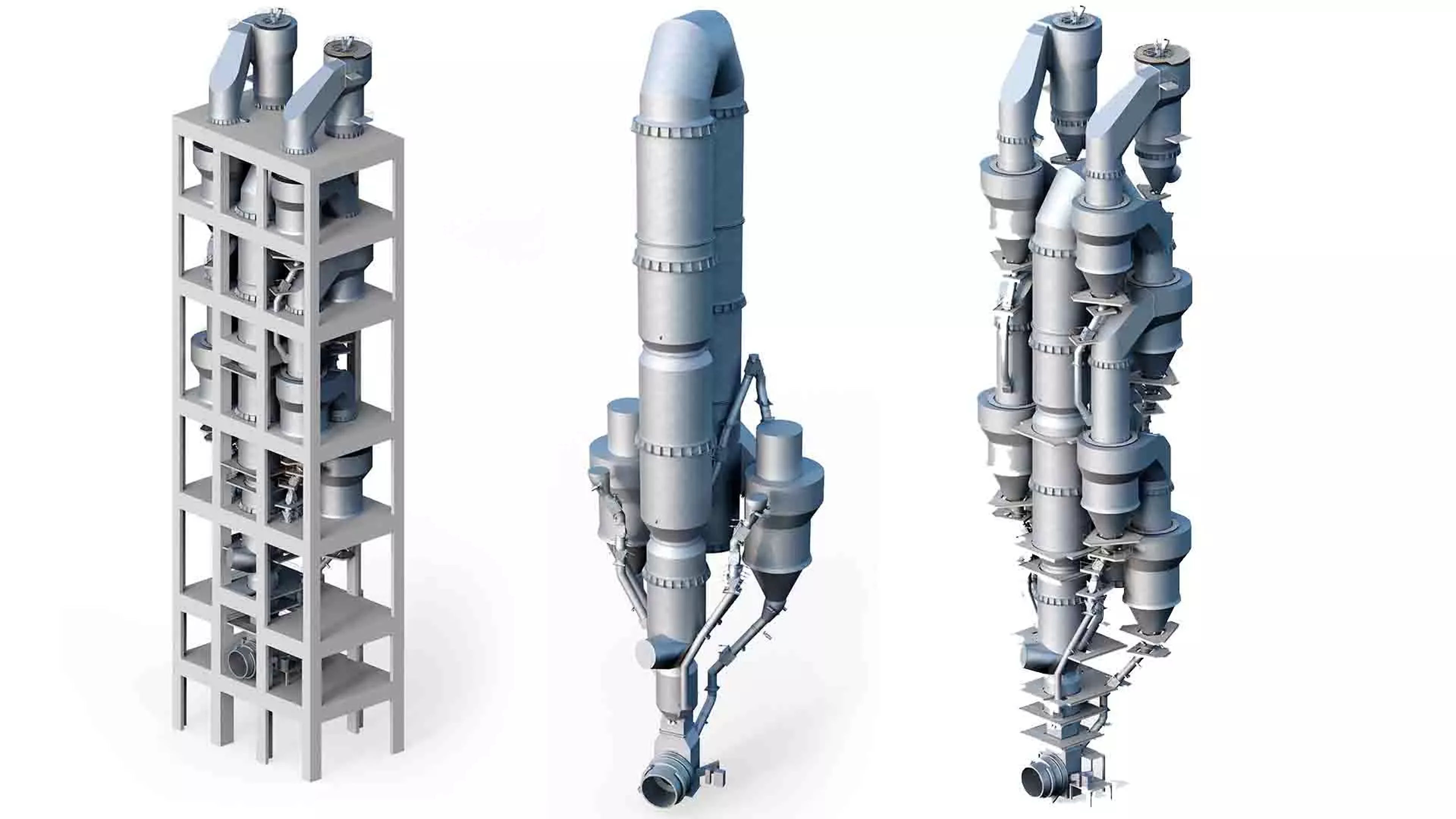A cost-effective, efficient in-line calciner that reduces NOX emissions

What we offer
Achieve NOX emissions limits without ammonia injection
Whether you are planning to build a new plant or upgrade your current calciner, the FLSmidth Low NOX Calciner provides the best value of any calciner on the market. Its unique design allows for optimum NOX reduction, reduced wall build-ups and lower operational costs. With a goal to optimise production costs, our Low NOX Calciner has been enhanced for operational stability, availability and combustion efficiency. NOX regulations are continuously being tightened around the world. Meeting NOX emissions limits is therefore a key demand for cement producers, not only because NOX-related issues, such as smog pollution, have a direct impact on the local society, but also because your plant’s license to operate is directly linked to its NOX emissions. The Low NOX Calciner helps you significantly reduce NOX emissions from your cement plant operations.

Reliable operations
Build-up of raw meal on the calciner's walls is a common operational challenge in calciners. It requires cleaning and can even cause unexpected shut-downs. Our Low NOX Calciner is designed to abate this issue. It features a unique way of introducing material into the reduction zone and the lower calciner, which protects the walls from build-ups, while also maintaining a hot core for excellent combustion and NOX reduction.
Extensive research and field tests
The unique design of the Low NOX Calciner is the result of extensive research. We have combined comprehensive field tests with Computational Fluid Dynamics (CFD) modelling to develop the most efficient calciner in the market. This includes the ability to burn almost any type of fuel – coal and natural gas, petcoke, and most solid and liquid waste fuels.
Reduced ammonia usage
Many cement producers find that primary NOX abatement technologies, such as calciners, don’t provide full compliance with the most stringent NOX emissions requirements. That's why many cement plants use ammonia in their secondary NOX reduction systems, such as costly SCR or SNCR systems. With our Low NOX Calciner, ammonia injection is less likely to be required, thus reducing your overall ammonia consumption.
Full lifecycle support
Throughout the lifecycle of your Low NOX Calciner, we can provide the support necessary to ensure it delivers on its promise. From planning and implementation to maintenance and supply of spare parts, you can rely on expert support from our global organisation, when and where you need it. Our Low NOX Calciner will have a significant long-term impact on your plant operations. Working closely with you, our experienced engineers ensure the calciner delivers to your operational goals.
The best-value in-line calciner for new plants and upgrades
The Low NOx Calciner’s efficient technology delivers a competitive total cost of ownership, helping your operations to deliver their true potential.
Low total cost of ownership
Two main factors contribute to reducing the total cost of ownership. First, reducing or even eliminating the need for ammonia. Second, higher availability due to fewer build-ups and less need for cleaning.
More efficient NOX reduction
This in-line calciner is already helping cement producers around the world significantly reduce NOX emissions. Its unique design creates an oxygen-deficient atmosphere and optimal operation temperatures, which promotes NOX reduction.
Reduce ammonia consumption
With our Low NOX Calciner, you are less likely to need ammonia-based SCR or SNCR systems to meet your emissions targets.
Flexible choice of fuel
Our Low NOX Calciner has the flexibility to burn almost any type of fuel – traditional fuels, including coal and natural gas, more difficult-to-burn fuels, such as petcoke, and most solid and liquid waste fuels.
Reduced build-ups and less cleaning
The reduction zone’s design with two raw meal inlets, as well as the unique way of introducing material into the reduction zone and the lower calciner, protects the walls from build-ups, while maintaining a hot core for efficient combustion and NOX reduction.
Future-proof NOX reduction with the Low NOX Calciner
The Low NOX Calciner is based on FLSmidth’s proven in-line calciner technology, boasting features that reduce NOX emissions, reduce ammonia consumption and minimise total cost of ownership.
How the reduction zone works
Fuel is injected into the kiln riser below the tertiary air inlet at the base of the calciner. The volume between the fuel inlet and tertiary air inlet has an oxygen-deficient atmosphere that promotes NOX reduction. The reduction zone is designed for optimal operation temperatures and adequate gas retention time. The temperature in the reduction zone is controlled by a material split from the second-lowest stage. This material split is also used to prevent potential build-ups in the kiln riser and the reduction zone.
Main calciner vessel
Located above the reduction zone is the main calciner vessel, which is divided into two or more sections separated by a notch. The changes in cross-sectional areas create turbulence that ensures effective mixing of fuel, meal and gas, improving heat transfer and combustion. The calciner outlet loop duct ensures optimum gas retention time, effective mixing and complete fuel burnout. You also have the option to split the second-lowest or third-lowest stage cyclone material to allow for diversion of a portion of the meal into the upper section of the calciner. This creates a “hot zone” in the lower section of the calciner that boosts the burning of difficult fuels and further NOX reduction.
Multiple fuel inlets
Multiple fuel inlets ensure optimal distribution between the kiln gases and the fuel. To achieve the best distribution between the kiln gases and the fuel, there are multiple coal inlets (four or six, depending on plant size). Better fuel distribution provides optimal mixing, which gives the highest average cross-sectional temperature without any build-up problems. Our Low NOX Calciner has the flexibility to burn almost any type of fuel. This includes traditional fuels, including coal and natural gas, more difficult-to-burn fuels, such as petcoke, and most solid and liquid waste fuels. All of these fuel types are burned while achieving low NOX and CO emissions.
Reduction zone and meal inlets
For optimal NOX reduction and minimised wall build-ups, the reduction zone has a round design with two raw meal inlets. The round design of the reduction zone with two raw meal inlets is the result of extensive modelling using Computational Fluid Dynamics (CFD). This has provided the optimum design to maintain a cool outer wall and hot inner gas core. Wall build-ups and maintenance cleaning costs are minimised, while the highest possible average temperature in the core can be attained for optimal NOX reduction.
Lower calciner
Based on field experience and CFD modelling, the unique design of the lower calciner optimises dispersion of the raw meal into the gas stream. An optional meal split also allows the bottom section of the calciner to operate as a hot zone, further improving combustion and lowering NOX emissions when burning difficult fuels such as petcoke or solid waste fuels.



.jpg?w=1080&q=80&auto=format)